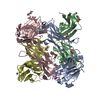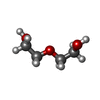+ Open data
Open data
- Basic information
Basic information
| Entry | Database: PDB / ID: 8t51 | ||||||
|---|---|---|---|---|---|---|---|
| Title | Crystal structure of Fab 3.10C2 bound to TREM2 | ||||||
 Components Components |
| ||||||
 Keywords Keywords | PEPTIDE BINDING PROTEIN / Antibody / Fab | ||||||
| Function / homology |  Function and homology information Function and homology informationpositive regulation of high-density lipoprotein particle clearance / regulation of toll-like receptor 6 signaling pathway / positive regulation of complement activation, classical pathway / detection of lipoteichoic acid / regulation of macrophage inflammatory protein 1 alpha production / regulation of hippocampal neuron apoptotic process / regulation of plasma membrane bounded cell projection organization / positive regulation of C-C chemokine receptor CCR7 signaling pathway / excitatory synapse pruning / positive regulation of CD40 signaling pathway ...positive regulation of high-density lipoprotein particle clearance / regulation of toll-like receptor 6 signaling pathway / positive regulation of complement activation, classical pathway / detection of lipoteichoic acid / regulation of macrophage inflammatory protein 1 alpha production / regulation of hippocampal neuron apoptotic process / regulation of plasma membrane bounded cell projection organization / positive regulation of C-C chemokine receptor CCR7 signaling pathway / excitatory synapse pruning / positive regulation of CD40 signaling pathway / negative regulation of triglyceride storage / negative regulation of cell activation / detection of peptidoglycan / positive regulation of macrophage fusion / import into cell / sulfatide binding / negative regulation of macrophage colony-stimulating factor signaling pathway / positive regulation of antigen processing and presentation of peptide antigen via MHC class II / negative regulation of fat cell proliferation / lipoteichoic acid binding / positive regulation of engulfment of apoptotic cell / positive regulation of establishment of protein localization / positive regulation of synapse pruning / microglial cell activation involved in immune response / negative regulation of toll-like receptor 2 signaling pathway / negative regulation of autophagic cell death / respiratory burst after phagocytosis / negative regulation of astrocyte activation / positive regulation of CAMKK-AMPK signaling cascade / semaphorin receptor binding / positive regulation of low-density lipoprotein particle clearance / positive regulation of microglial cell migration / apolipoprotein A-I binding / Other semaphorin interactions / detection of lipopolysaccharide / T cell activation via T cell receptor contact with antigen bound to MHC molecule on antigen presenting cell / CXCL12-activated CXCR4 signaling pathway / negative regulation of neuroinflammatory response / negative regulation of toll-like receptor 4 signaling pathway / high-density lipoprotein particle binding / negative regulation of p38MAPK cascade / very-low-density lipoprotein particle binding / cellular response to oxidised low-density lipoprotein particle stimulus / negative regulation of glial cell apoptotic process / complement-mediated synapse pruning / dendritic cell differentiation / microglial cell proliferation / positive regulation of microglial cell activation / phagocytosis, recognition / semaphorin receptor complex / amyloid-beta clearance by cellular catabolic process / low-density lipoprotein particle binding / cellular response to lipoprotein particle stimulus / regulation of resting membrane potential / negative regulation of NLRP3 inflammasome complex assembly / positive regulation of phagocytosis, engulfment / regulation of TOR signaling / cellular response to peptidoglycan / peptidoglycan binding / regulation of oxidative stress-induced neuron intrinsic apoptotic signaling pathway / positive regulation of chemotaxis / positive regulation of amyloid-beta clearance / positive regulation of potassium ion transport / semaphorin receptor activity / phosphatidylethanolamine binding / positive regulation of proteasomal protein catabolic process / positive regulation of osteoclast differentiation / negative regulation of amyloid fibril formation / cellular response to lipid / kinase activator activity / regulation of interleukin-6 production / dendritic spine maintenance / apoptotic cell clearance / negative regulation of interleukin-1 beta production / phagocytosis, engulfment / regulation of innate immune response / phosphatidylserine binding / pyroptotic inflammatory response / regulation of cytokine production involved in inflammatory response / negative regulation of cholesterol storage / cellular response to lipoteichoic acid / lipid homeostasis / lipoprotein particle binding / amyloid-beta clearance / positive regulation of ATP biosynthetic process / humoral immune response / positive regulation of intracellular signal transduction / positive regulation of interleukin-10 production / regulation of lipid metabolic process / apolipoprotein binding / plasma membrane raft / negative regulation of tumor necrosis factor production / social behavior / positive regulation of cholesterol efflux / positive regulation of TOR signaling / response to axon injury / negative regulation of canonical NF-kappaB signal transduction / negative regulation of cytokine production involved in inflammatory response / astrocyte activation / negative regulation of phosphatidylinositol 3-kinase/protein kinase B signal transduction Similarity search - Function | ||||||
| Biological species |  Homo sapiens (human) Homo sapiens (human) | ||||||
| Method |  X-RAY DIFFRACTION / X-RAY DIFFRACTION /  SYNCHROTRON / SYNCHROTRON /  MOLECULAR REPLACEMENT / Resolution: 1.9 Å MOLECULAR REPLACEMENT / Resolution: 1.9 Å | ||||||
 Authors Authors | Hsu, P.L. / Wallweber, H. | ||||||
| Funding support |  United States, 1items United States, 1items
| ||||||
 Citation Citation |  Journal: Nat Commun / Year: 2024 Journal: Nat Commun / Year: 2024Title: Rapid affinity optimization of an anti-TREM2 clinical lead antibody by cross-lineage immune repertoire mining. Authors: Hsiao, Y.C. / Wallweber, H.A. / Alberstein, R.G. / Lin, Z. / Du, C. / Etxeberria, A. / Aung, T. / Shang, Y. / Seshasayee, D. / Seeger, F. / Watkins, A.M. / Hansen, D.V. / Bohlen, C.J. / Hsu, P.L. / Hotzel, I. | ||||||
| History |
|
- Structure visualization
Structure visualization
| Structure viewer | Molecule:  Molmil Molmil Jmol/JSmol Jmol/JSmol |
|---|
- Downloads & links
Downloads & links
- Download
Download
| PDBx/mmCIF format |  8t51.cif.gz 8t51.cif.gz | 388.1 KB | Display |  PDBx/mmCIF format PDBx/mmCIF format |
|---|---|---|---|---|
| PDB format |  pdb8t51.ent.gz pdb8t51.ent.gz | 310.3 KB | Display |  PDB format PDB format |
| PDBx/mmJSON format |  8t51.json.gz 8t51.json.gz | Tree view |  PDBx/mmJSON format PDBx/mmJSON format | |
| Others |  Other downloads Other downloads |
-Validation report
| Summary document |  8t51_validation.pdf.gz 8t51_validation.pdf.gz | 524.6 KB | Display |  wwPDB validaton report wwPDB validaton report |
|---|---|---|---|---|
| Full document |  8t51_full_validation.pdf.gz 8t51_full_validation.pdf.gz | 537.5 KB | Display | |
| Data in XML |  8t51_validation.xml.gz 8t51_validation.xml.gz | 42.2 KB | Display | |
| Data in CIF |  8t51_validation.cif.gz 8t51_validation.cif.gz | 60.3 KB | Display | |
| Arichive directory |  https://data.pdbj.org/pub/pdb/validation_reports/t5/8t51 https://data.pdbj.org/pub/pdb/validation_reports/t5/8t51 ftp://data.pdbj.org/pub/pdb/validation_reports/t5/8t51 ftp://data.pdbj.org/pub/pdb/validation_reports/t5/8t51 | HTTPS FTP |
-Related structure data
| Related structure data |  8t59C C: citing same article ( |
|---|---|
| Similar structure data | Similarity search - Function & homology  F&H Search F&H Search |
- Links
Links
- Assembly
Assembly
| Deposited unit | 
| ||||||||
|---|---|---|---|---|---|---|---|---|---|
| 1 | 
| ||||||||
| 2 | 
| ||||||||
| Unit cell |
| ||||||||
| Components on special symmetry positions |
|
- Components
Components
-Protein/peptide , 1 types, 2 molecules EF
| #3: Protein/peptide | Mass: 2274.378 Da / Num. of mol.: 2 / Source method: obtained synthetically / Source: (synth.)  Homo sapiens (human) / References: UniProt: Q9NZC2 Homo sapiens (human) / References: UniProt: Q9NZC2 |
|---|
-Antibody , 2 types, 4 molecules ACBD
| #1: Antibody | Mass: 23694.543 Da / Num. of mol.: 2 Source method: isolated from a genetically manipulated source Source: (gene. exp.)  Homo sapiens (human) / Cell line (production host): Expi293 / Production host: Homo sapiens (human) / Cell line (production host): Expi293 / Production host:  Homo sapiens (human) Homo sapiens (human)#2: Antibody | Mass: 23974.928 Da / Num. of mol.: 2 Source method: isolated from a genetically manipulated source Source: (gene. exp.)  Homo sapiens (human) / Cell line (production host): Expi293 / Production host: Homo sapiens (human) / Cell line (production host): Expi293 / Production host:  Homo sapiens (human) Homo sapiens (human) |
|---|
-Non-polymers , 6 types, 566 molecules 










| #4: Chemical | ChemComp-SO4 / #5: Chemical | ChemComp-ZN / #6: Chemical | ChemComp-GOL / #7: Chemical | ChemComp-ACT / #8: Chemical | ChemComp-PEG / #9: Water | ChemComp-HOH / | |
|---|
-Details
| Has ligand of interest | N |
|---|---|
| Has protein modification | Y |
-Experimental details
-Experiment
| Experiment | Method:  X-RAY DIFFRACTION / Number of used crystals: 1 X-RAY DIFFRACTION / Number of used crystals: 1 |
|---|
- Sample preparation
Sample preparation
| Crystal | Density Matthews: 2.37 Å3/Da / Density % sol: 48.21 % |
|---|---|
| Crystal grow | Temperature: 293 K / Method: vapor diffusion, sitting drop Details: 0.1 M MES pH6.5, 0.01 M ZnSO4, 25% PEG MME 550, 0.01 M Praseodymium acetate hydrate |
-Data collection
| Diffraction | Mean temperature: 100 K / Serial crystal experiment: N |
|---|---|
| Diffraction source | Source:  SYNCHROTRON / Site: SYNCHROTRON / Site:  APS APS  / Beamline: 24-ID-C / Wavelength: 1 Å / Beamline: 24-ID-C / Wavelength: 1 Å |
| Detector | Type: DECTRIS EIGER X 16M / Detector: PIXEL / Date: Mar 23, 2021 |
| Radiation | Protocol: SINGLE WAVELENGTH / Monochromatic (M) / Laue (L): M / Scattering type: x-ray |
| Radiation wavelength | Wavelength: 1 Å / Relative weight: 1 |
| Reflection | Resolution: 1.9→38.9 Å / Num. obs: 73396 / % possible obs: 99.9 % / Redundancy: 6.7 % / CC1/2: 0.998 / Rmerge(I) obs: 0.122 / Net I/σ(I): 12.9 |
| Reflection shell | Resolution: 1.9→1.968 Å / Num. unique obs: 7234 / CC1/2: 0.626 |
- Processing
Processing
| Software |
| ||||||||||||||||
|---|---|---|---|---|---|---|---|---|---|---|---|---|---|---|---|---|---|
| Refinement | Method to determine structure:  MOLECULAR REPLACEMENT / Resolution: 1.9→1.968 Å / Cross valid method: FREE R-VALUE MOLECULAR REPLACEMENT / Resolution: 1.9→1.968 Å / Cross valid method: FREE R-VALUE
| ||||||||||||||||
| Refinement step | Cycle: LAST / Resolution: 1.9→1.968 Å
|
 Movie
Movie Controller
Controller



 PDBj
PDBj






